Nikōji:
A temple built by immigrants? Buddha image tiles in large numbers, including ones with foreign-looking faces.
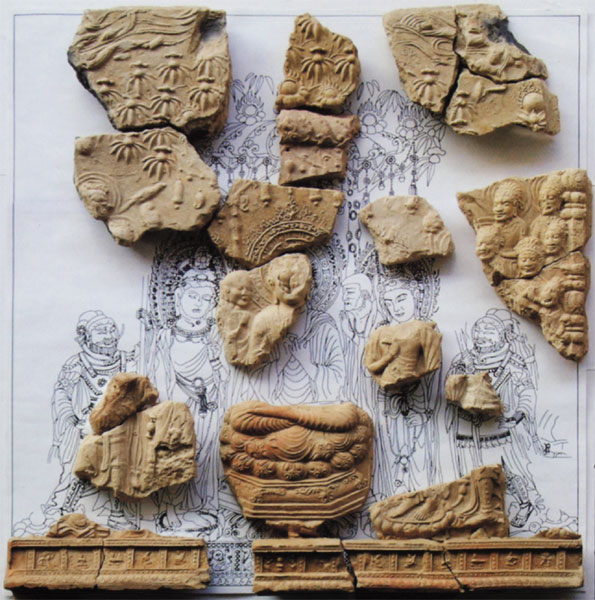
Large-scale tile with multiple Buddha images in relief Centered on a Nyorai (Buddha) image seated in full-lotus position atop a lotus pedestal, attended to the left and right by standing Bodhisattva images of Kannon (Avalokitesvara) and Seishi (Mahasthamaprapta), also on lotus pedestals. A canopy and branches of the Bo tree spread overhead, to the right and left of which heavenly beings dance in the sky. | |
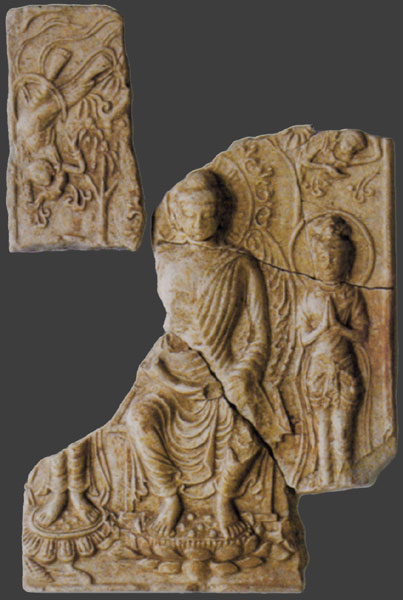
Rectangular Buddhist triad image tile Centered on a Nyorai image seated on a chair, with both feet resting upon a lotus pedestal, standing Bodhisattva images with hands clasped in prayer are seen to the right and left. A canopy spreads above the main image, and to the right and left heavenly beings with twisted bodies dance in the sky. 
Remains of a pillar base stone building and podium (from the east) |
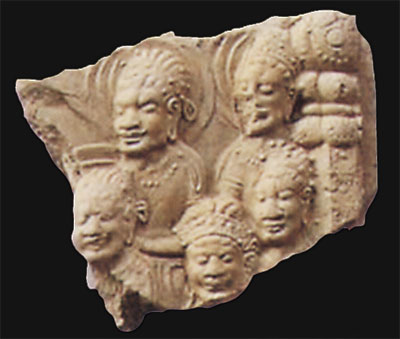
Foreign faces among the attendant devotees Buddha image tiles are bricks decorated with Buddhist images in relief, used to decorate the inner walls of temples. 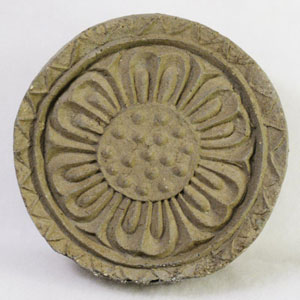
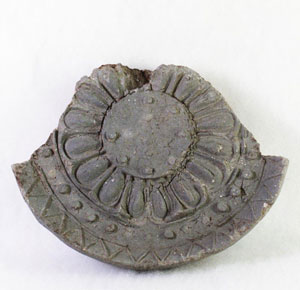
Round eave tiles recovered from the Nikōji abandoned temple (Above) Same-mold pattern with the Asazuma abandoned temple. (Below) Same-mold pattern with the Takamiya abandoned temple |
Nikōji Abandoned Temple, Gose City, Nara Prefecture
An Asuka period temple is newly discovered
The Nikōji abandoned temple is an Asuka period (seventh century, latter half) temple located at 260 m above sea level on the slope of the eastern foothills of Mt. Kongō, which forms the boundary between Nara and Osaka Prefectures. The presence of a temple was first discovered in an excavation conducted prior to the construction of agricultural facilities. In addition to the presence of a building constructed with pillar base stones, thought to be the temple’s main hall, along with the podium on which it stood, and large quantities of tiles in the vicinity, the recovery of more than 200 fragments of Buddha image tiles and the spiral hair curl from a clay Buddha image are noteworthy.
The podium for a pillar-base stone building, along with roof and image tiles
After investigating the eastern half of the podium, from the position of the pillar base stones it is clear that building had a span of four bays between the pillars in the north-south direction, and five bays between pillars lined up east-west, and that the building faced south. The podium had natural stones piled up around its perimeter, and was originally thought to have been about one meter in height. Among the eave tiles recovered from the site are round tiles, having a compound lotus petal design, that were made with the same mold as those used at temples thought to have been built by noble families that had immigrated from China and the Korean peninsula (namely, the Asazuma abandoned temple in Gose, the designated historic site Takamiya abandoned temple, the Asuka Village historic site Hinokuma temple), plus flat eave tiles with concentric arc patterns and one-way intertwining floral designs. Four types of bas relief Buddha image tiles were recovered: a large-scale tile with multiple Buddha images, a rectangular Buddha triad image tile, a rectangular tile with a repetition of six standing Buddha images, and a rectangular tile with a repetition of six seated Buddha images. The large-scale multiple Buddha image tile is inscribed with the sexagenary date “Kinoe-uma [year], fifth month,” which possibly indicates the year 694. This type of Buddha image tile is known from Hōryūji and from the designated historic site Natsumi abandoned temple in Mie Prefecture, but the fragment containing images of a group of devotees attending the central figures is a newly discovered icon, and is extremely important from the perspectives of both archaeology and Buddhist art history. From the same-mold relations of the eave tiles, and from artifacts recovered from the neighboring group of mounded tombs, it is thought possible that the Nikōji temple was built by families of immigrants. (Hirooka Takanobu)
